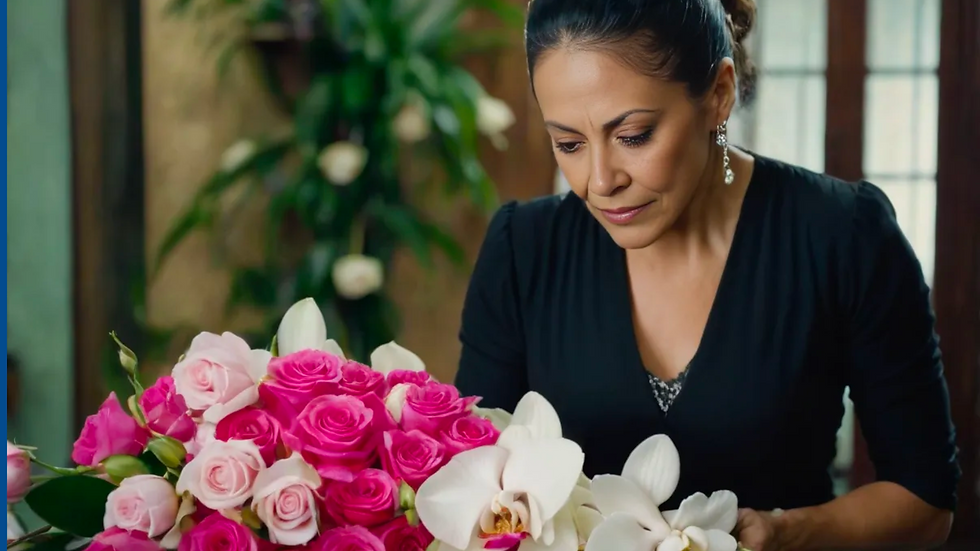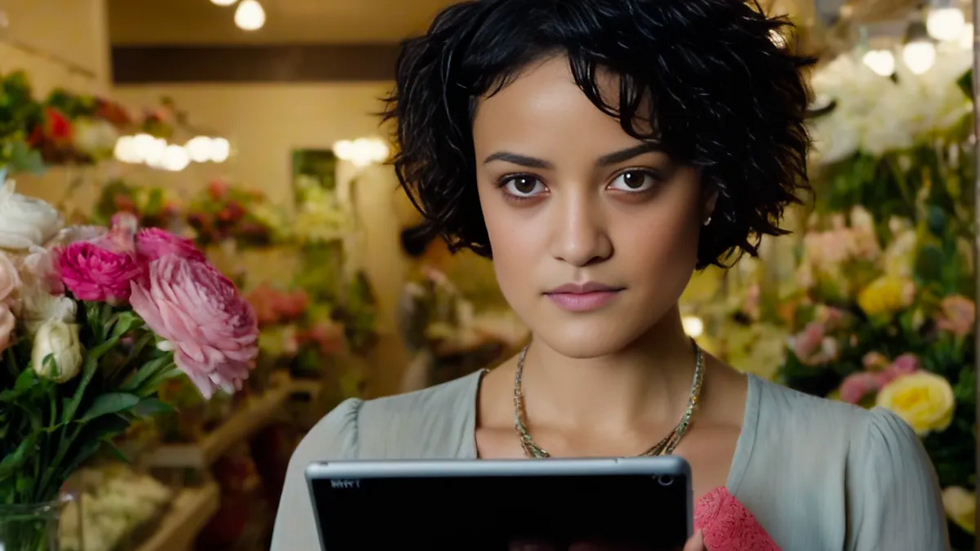The Tale of Two Florists for AI & Tech in Business - Chapter 5
- annelize3
- Aug 28, 2024
- 4 min read
Updated: Dec 17, 2024

Chapter 5 - The Wedding
Previously: After the destructive storm, Maria and Elena - two florists from different generations - each navigated the business challenges in their own way. Their different approaches to and use of technology is where the story lies. We continue.
It's been months since the storm hit the two neighborhoods and recovery has been slow.
Yet, the heavens smiled on the florists: they each landed a huge society wedding.

Maria’s opportunity fell into her lap through a friend of a friend. She was thrilled about the prospect of such a significant order. This was no ordinary wedding—the flowers alone would cost $30,000.
Maria managed it as she always had.
She met with the couple in person and showed them her portfolio of previous floral creations. They loved her style and decided on two shades of pink roses with large exotic orchids to complement. They signed a paper contract specifying the service, cancellation policy, and payment terms.
Maria then went to work sourcing the flowers, which wasn't easy given the sheer number she needed.
After many hours on the phone, she finally secured the orders and invoiced the couple for 30% of the cost.
The credit card payment cleared, and she confirmed the orders. She was just annoyed, as always, at the fees charged for accepting credit cards. With multiple transactions a day, it adds up.
The flowers arrived in good time, and Maria got to work. She invoiced the couple for another 30% to secure the work. Ultimately, this agreement relied on trust.

No payment came through though.
She followed up and found that the couple was traveling. Due to poor bandwidth where they were, they struggled to connect online or even receive phone calls. Maria was getting anxious as she had to transfer funds to the supplier who didn’t accept credit card payments.
The couple came through, making the payment on Thursday. Payment was due Monday.
She was pleased to see the payment land in her accounting software's banking system on Friday. She just had to transfer that over to her bank account to make payment. But she soon realized that the weekend was in the way and the funds would only arrive in her account on Tuesday.
She had to make another call to the supplier to make alternate arrangements. This was all very annoying and time-consuming.

It all worked out in the end, and finally, Maria delivered the flowers to the wedding venue and set it up. A check for the balance was waiting for her with the wedding planner.
She was pleased with the outcome but exhausted and a little anxious, wondering if the final check would clear without a hitch.
Two hours away in the next town, granddaughter Elena also had her hands full.

She had landed her wedding contract through her Art Voucher project and approached it quite differently.
First, she met the couple in person to get acquainted. That was followed by virtual calls to look at Elena's previous work and discuss potential designs. Elena created mockups of her designs in 3D animation software to give the bride a clearer picture of what to expect.
They settled on a design and the flowers.
Since the couple were both digital natives, Elena opted for a smart contract. This contract was different from the smart contracts she’d used for the art vouchers. While the art voucher contracts stipulated the art provenance and owner benefits, this wedding smart contract served as an escrow vehicle.
The contract locked in the total amount as a digital asset using stable coin, which is linked to the US dollar.
The contract stipulated deliverables and timelines with payment clauses and penalties for non-compliance.
As Elena completed each milestone, it was recorded in the smart contract and locked into the blockchain, releasing the funds automatically into her digital wallet. For example, she ordered the flowers and shared verification. With that portion of the agreement fulfilled, the funds were released. The wedding couple had peace of mind because there was complete transparency on the delivery process.

The payments Elena received as each milestone was concluded got transferred to her digital wallet. Elena had a choice. She could either use these funds to pay her forward-thinking suppliers with peer-to-peer payments or convert them back into fiat US dollars.
All went well with the preparations, and the day of the wedding finally arrived. Elena delivered the flowers and completed the floral setup. She was pleased with the outcome, and so was the wedding planner.
Elena presented the wedding planner with a QR code to scan and confirm satisfactory delivery, triggering the final payment from the escrow account.

Looking back, Elena realized she hadn’t had a moment of stress about non-payment, which meant she could plan her cash flow without any hesitation. She felt bad about the anxiety her grandmother Maria had gone through in comparison. She really did need to get her grandma to come around to New Tech.
This was the before-and-after Tale of Two Florists and how AI and disruptive tech can be integrated into cash flow management.
While this is a fictional tale, the described tools and scenarios are all available today, even if they aren’t mainstream.
What is significant about the tale of integrating disruptive tech into a business, is not the tech per se. Rather, it is about how tech is viewed and approached.
To understand the future of business, consider this:
📍First, disruptive tech isn't something unattainable or far-fetched in a distance future. It is here and available today.
📍Second, integrating disruptive tech into your business doesn't mean recreating everything. Instead, it’s about reviewing every aspect of your business and finding the right tools to create optimal results that address current challenges.
📍Third, the future of business isn’t just about adding tech. It is in fact more about a new collaborative partnership between the human and tech, finding fresh and creative opportunities to band together to better serve clients, bring previously unimagined value and creating a more efficient and profitable business.
As you get started on your own journey, what do you need to rethink to get to that point?
👉 One thing is clear: the future isn’t a distant vision for the next generation. It is in fact within your reach. Exploring AI disruptive technologies today will undoubtedly set you apart tomorrow.
Don’t hesitate.
Start now and gain the edge that will keep you ahead of the competition.
Contact me today to learn how Personal Training in AI can transform your business and put you on the path to success.


Comments